Items
Mediator is exactly
Indigenous POV
-
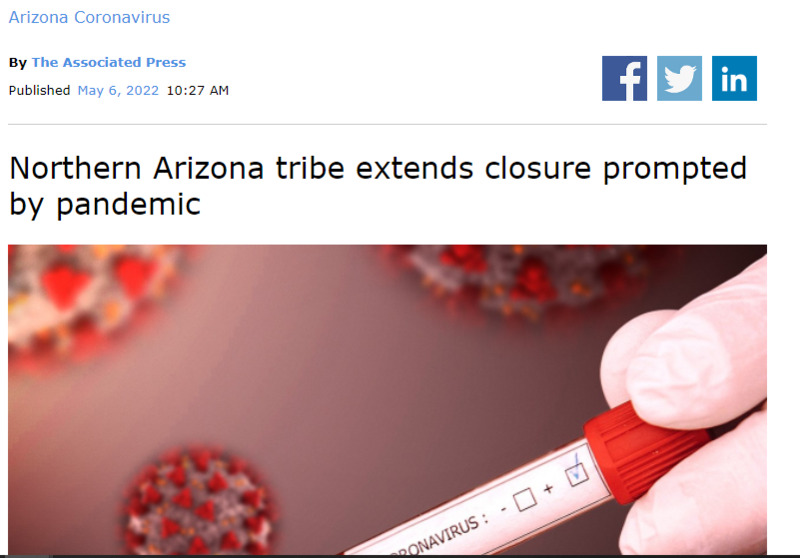 2022-05-06
2022-05-06Northern Arizona tribe extends closure prompted by pandemic
This is a news story by the Associated Press. The Havasupai Tribe, a tribe located in Northern Arizona, has closed its reservation through the 2022 tourism season. The reservation has been known for its large waterfalls. Other repairs are needed in the reservation too, including trailheads, camp grounds, and lodges. -
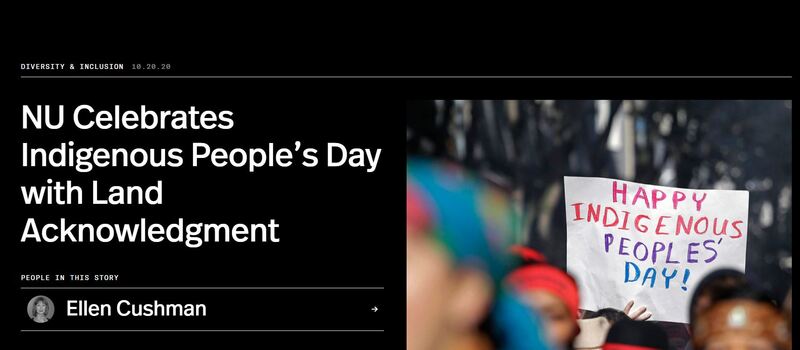 2020-10-20
2020-10-20Northeastern Virtual Indigenous People's Day 2020
Article regarding virtual Indigenous People's Day. -
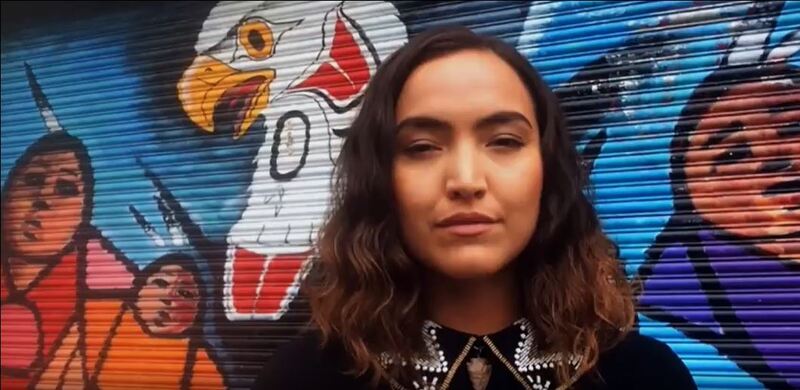 2021
2021What Does It Mean to Be Indigenous?
This is a video on being Indigenous by CBC News. -
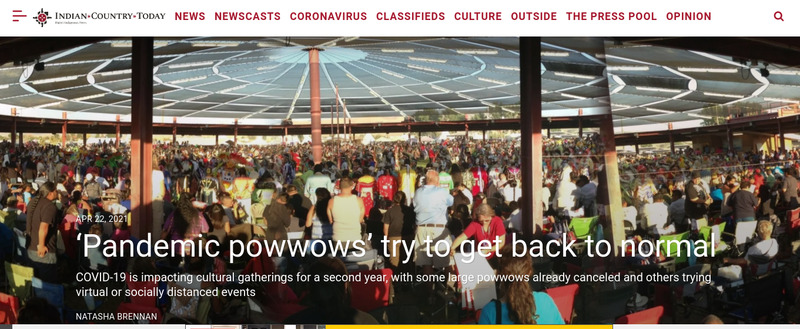 2020-09-14
2020-09-14Virtual Pow Wows - A result of Covid -19
Every year as a tradition Tribes of Native Americans gather to celebrate through song and dance at events known as Pow Wows. These events reinforce long-honored traditions, the most important being unification. The Pow wows allow for the togetherness of the people and the connectedness of the tribes. Covid -19 brought an abrupt halt to that for hundreds of indigenous tribes across the U.S and Canada. As a result, the only way to share some of these meaningful traditions was to offer a virtual option. While not the same it did allow for some of the singing and dancing competitions to take place. The long-term after effect though is that not having the in-person Pow Wow resulted in a significant loss of revenue for those tribes that were hosting the event. Pow Wows bring in significant revenue from vendors and non-indigenous spectators. This loss has had a trickle-down effect on the indigenous communities making it more difficult to endure the pandemic. As a parent of a Northeastern student, not having the ability to have my daughter physically share in the in-person powwows is disappointing. Pow wows are more than just celebrations they are an opportunity to connect with your identity and heritage-which is vital for the younger generations. -
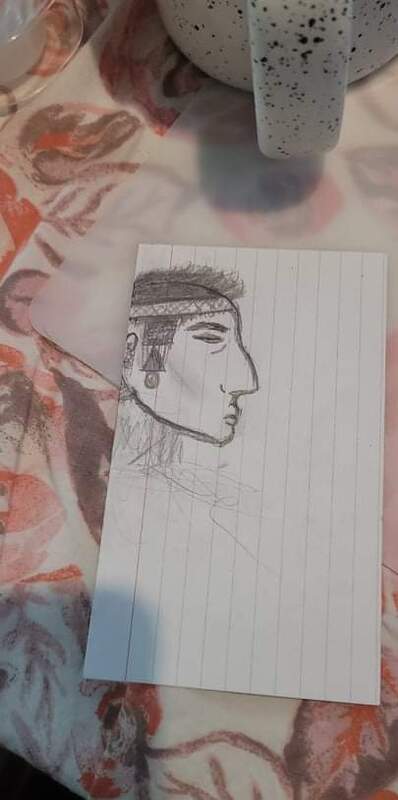 2020-03
2020-03Being Indigenous During COVID-19
I am a Game Art major at Full Sail University, but my sister goes to Northeastern University, so we are a Northeastern family. I am of Mayan descent, so living through COVID-19 was a little scary because we got all the news and updates about how COVID-19 was ravaging Mayan communities in Guatemala. We live in the USA in a rural area, so we were a little "safer," but the fear remained. I am proud of my people and my heritage, and I don't doubt our ability to survive the pandemic. Here is a quick sketch I made. -
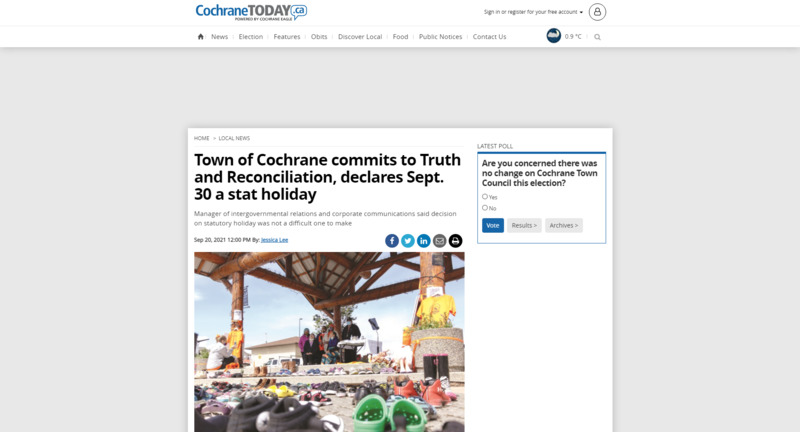 2021-09-20
2021-09-20Town of Cochrane commits to Truth and Reconciliation, declares Sept. 30 a stat holiday
This is a newspaper from Cochrane Today, a subsidiary of the Cochrane Eagle on the adoption of the National day of Truth and Reconciliation in the town of Cochrane. The document talks about how other municipalities and even the provincial government have chosen not to participate in the first day of this incredibly important national holiday. -
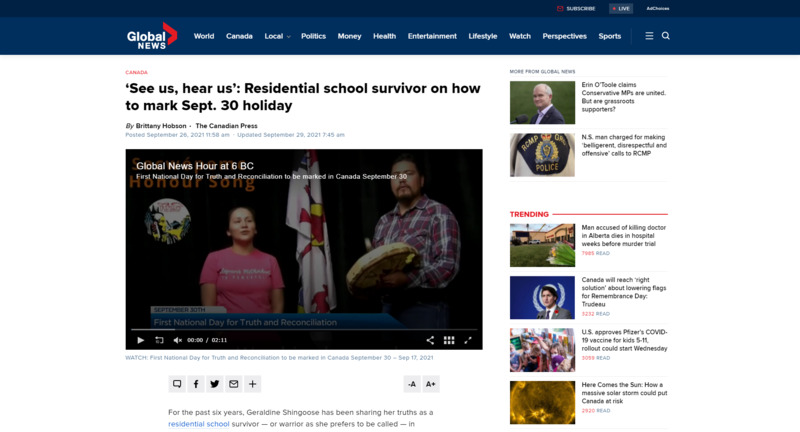 2021-09-26
2021-09-26‘See us, hear us’: Residential school survivor on how to mark Sept. 30 holiday
This is a news article documenting Geraldine Shingoose’s comments on how the new national holiday of Truth and Reconciliation must be observed; the article contains a video and conversations regarding how to teach children about Residential Schools in classrooms. -
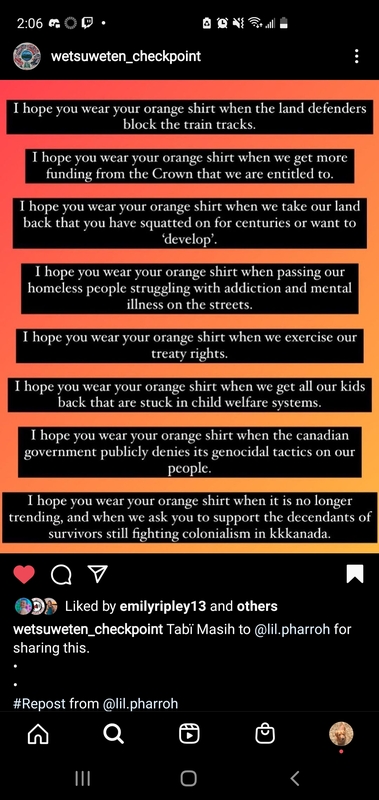 2021-09-30
2021-09-30I hope you wear your orange shirt
A post on Instagram about the need for continual support for Indigenous peoples when it comes to protecting their sovereignty; and in resisting colonialism. -
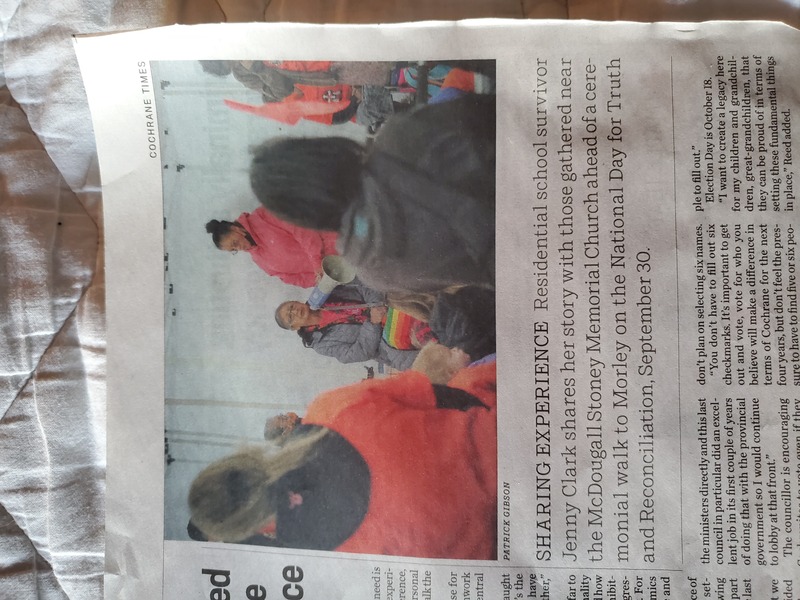 2021-10-06
2021-10-06Sharing Experience, Cochrane Times, October 6th 2021.
2.) This is another photo within the Cochrane Times dedicated to documenting Canada’s first Orange Shirt Day; this was an article from the October 6th paper. The text underneath the photo reads: “Sharing Experience, Residential school survivor Jenny Clark shares her story with those gathered near the McDougall Stoney Memorial Church ahead of a ceremonial walk to Morley on the National Day for Truth and Reconciliation, September 30. -
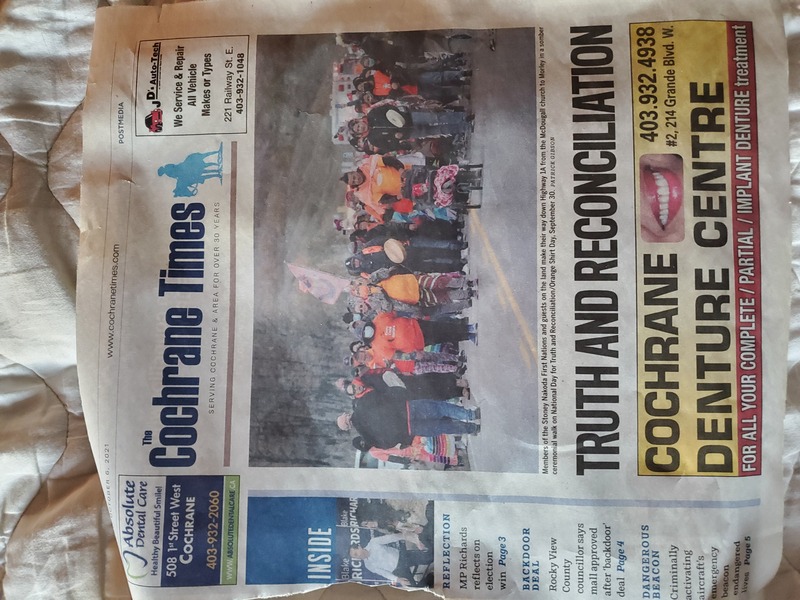 2021-10-06
2021-10-06Cochrane Times October 6th, 2021 (1)
1.) This is the FrontPage paper for the Cochrane Times newspaper on October 6th, 2021. The front page’s photo content is as follows: “Members of the Stoney Nakoda First Nations and guests on the land make their way down Highway 1A from the McDougall church to Morley in a somber ceremonial walk on National Day for Truth and Reconciliation/Orange Shirt Day, September 30” -
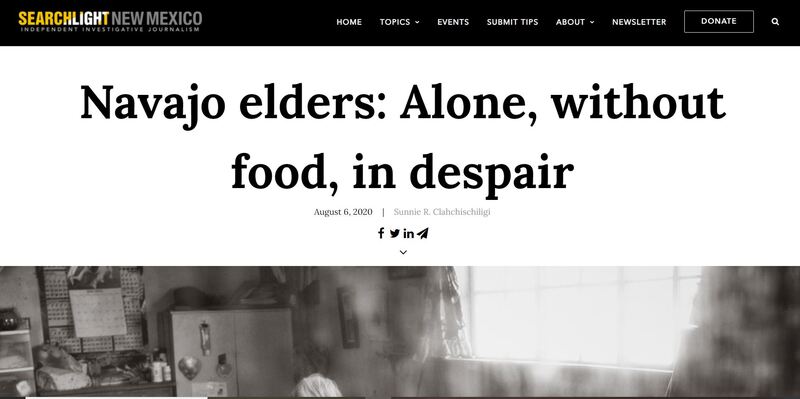 2020-08-06
2020-08-06Native American / Navajo Elders
I live relatively close to the Navajo reservation and my elderly father lived with me during the pandemic. The experiences of suffering of Navajo elders so close by is heartbreaking but tells the story of deep divides in resources and experiences. -
 2021-09-14
2021-09-14Tohono O'odham Nation rolling out vaccine incentive program
Efforts by the Tohono O'odham Nation to combat COVID-19 and increase the percentage of tribal members who are vaccinated. The Tohono O'odham Nation to pay tribal members $400 if they can prove they’re fully vaccinated against COVID-19 by mid-November. -
 2021-09-24
2021-09-24Power of 100 Vaxx Fest poster
Shared in Facebook by Tsuutina Comm. The poster is directed at indigenous people in the Canadian Province of Alberta. It advertises three days of events (24-26 September 2021) that those who get vaccinated at the event will also receive a swag bag; that there will be draws for gift cards, Macbooks, and iPads; social media influencers present; live music; drive-in-movies; and food. -
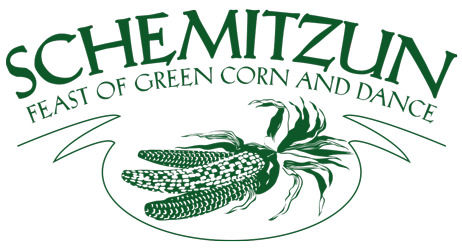 2021-08-28
2021-08-28Schemitzun
I attended an indigenous festival at the end of August 2021 called Schemitzun. Called the "Feast of Green Corn and Dance," the powwow took place on Mashantucket Pequot grounds and hosted various tribes competing in music and dance. My family and I attended as audience members and we were truly struck by the spirit of the event. The main announcer explained at various points during the festival that this year's powwow was very special, since Covid-19 had canceled the event the year before. He explained that events like Schemitzun keep the indigenous community connected and vibrant, and this year's event was meant to be a celebration of perseverance and survival. I found it incredibly powerful that indigenous communities continue to thrive and grow despite centuries of struggle, and managed to survive the Covid-19 pandemic on top of that. -
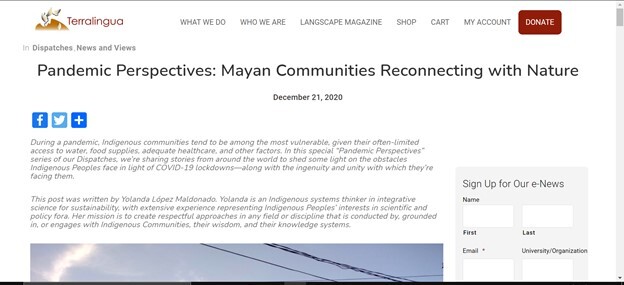 2020-12-21
2020-12-21Mayans and Covid-19
The topic of Language & Communication during the Covid-19 pandemic stood out to me because my father was from Guatemala, and I am of Mayan descent. I recently read an article from last year discussing the impact of Covid-19 on indigenous communities, especially the Mayans. The article mentions how certain problems were exacerbated by the pandemic: for example, the inability to effectively communicate the pandemic situation across many dialects. Despite a variety of struggles, the article highlights several benefits that Mayan communities experienced, including a renewed sense of community, culture, and farming. -
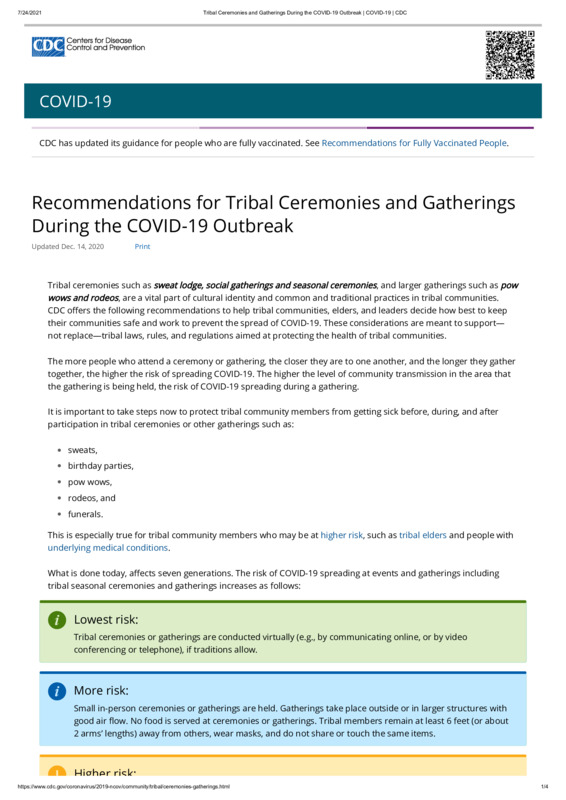 2020-12-14
2020-12-14Recommendations for Tribal Ceremonies and Gatherings During the COVID-19 Outbreak
These are COVID-19 recommendations from the CDC specifically addressing tribal ceremonies such as sweat lodge, social gatherings and seasonal ceremonies. -
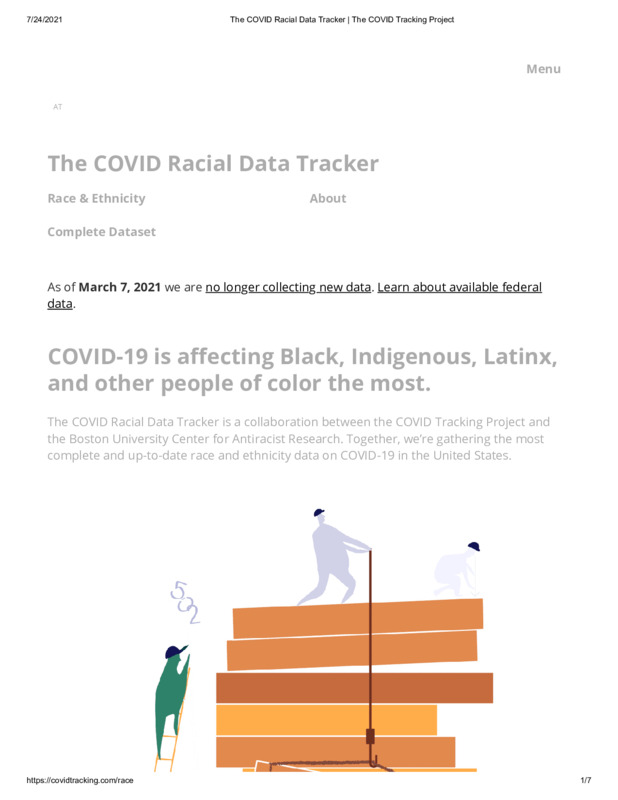 2021-03-07
2021-03-07The COVID Racial Data Tracker
This data tracker showed how Covid-19 disproportionately affected black, Latinx, and indigenous communities. -
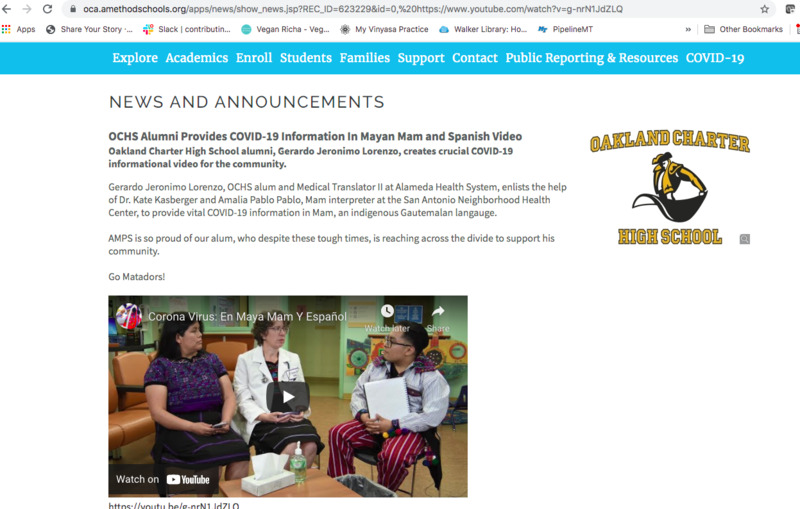 2020-03-18
2020-03-18OCHS Alumni Provides COVID-19 Information In Mayan Mam and Spanish Video
Oakland Charter High School alumni, Gerardo Jeronimo Lorenzo, creates crucial COVID-19 informational video for the community. Gerardo Jeronimo Lorenzo, OCHS alum and Medical Translator II at Alameda Health System, enlists the help of Dr. Kate Kasberger and Amalia Pablo Pablo, Mam interpreter at the San Antonio Neighborhood Health Center, to provide vital COVID-19 information in Mam, an indigenous Gautemalan [sic] langauge [sic]. AMPS is so proud of our alum, who despite these tough times, is reaching across the divide to support his community. Go Matadors! -
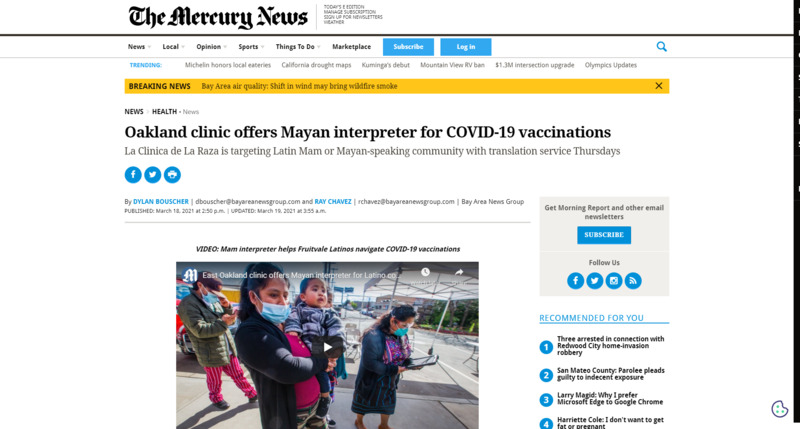 2021-03-18
2021-03-18Oakland clinic offers Mayan interpreter for COVID-19 vaccinations
Oakland clinic offers Mayan interpreter for COVID-19 vaccinations La Clinica de La Raza is targeting Latin Mam or Mayan-speaking community with translation service Thursdays OAKLAND — A new COVID-19 vaccination clinic in the Fruitvale neighborhood is offering interpreter services for the Latin Mam or Mayan-speaking community. This month, La Clinica de La Raza began offering the community-targeted vaccination service at 32 locations across the Bay Area, including ASCEND Elementary School on East 12th Street, where Latinos who speak Mam, K’iche ‘and Q’eqchi’ can get translation help from appointment to inoculation on Thursdays. There are over 22 different Mam dialects spoken primarily by people of Guatemalan and Mexican descent. According to a recent UC San Francisco study, Mayan people with Guatemalan roots are the fastest-growing ethnic group in Oakland. “I’m here to support my community, getting them the service that they deserve,” Brenda Sucely Perez, the on-site interpreter at ASCEND, said last week while about 450 eligible people were vaccinated. Staff at the Fruitvale site have administered roughly 2,000 Moderna vaccines per week since opening on March 4, according to La Clinica officials. Salvador Garcia, an Oakland firefighter, volunteered at the vaccination clinic. “Coming to get the vaccination is a good thing because it would help prevent the spread,” Garcia said, adding that it’s especially important given how close relatives in the Latino community live. “When you’re around people in such tight quarters around here, the way the families live with each other, it’s just good to have the preventative measure of the vaccination.” It’s also one of the reasons the nation’s first and strictest stay-at-home orders proved ill-suited for the hard-hit Latino community, a four-month Bay Area News Group investigation found. That analysis showed case rates for the region’s Latino residents are nearly four times higher than White residents, while the Latino population has fared worse against the virus across California. During the fall case surge, economic pressure to keep working outside the home became another major factor in the Latino community’s higher COVID-19 positivity rate in the Fruitvale neighborhood than the rest of the state, according to a UCSF study conducted in September. The results of that study found that antibody-positive prevalence was 9.8% overall among people who live and work in Fruitvale, a predominantly Latino neighborhood. The number spiked to 26.8% among the Latin Mam, or Mayan, speaking community, USCF [sic] researchers noted. The COVID-antibody test shows that someone once had coronavirus. -
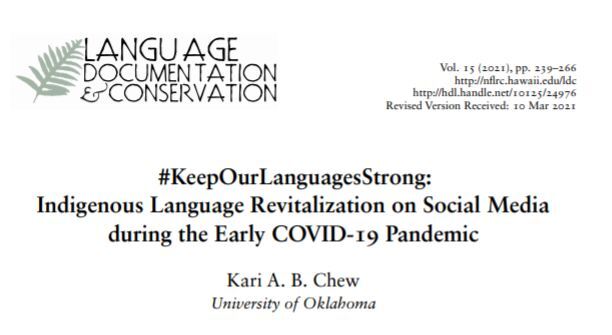 2021-03-10
2021-03-10#KeepOurLanguagesStrong: Indigenous Language Revitalization on Social Media during the Early COVID-19 Pandemic
This is a paper by Kari A. B. Chew at the University of Oklahoma that reviews language revitalization efforts during the early part of the COVID-19 pandemic. The paper focuses on revitalization efforts among Indigenous groups in the United States and Canada. -
 2021-04-02
2021-04-02Strength and Innovation of Indigenous Communities During the Pandemic
This article demonstrates that despite the inequities faced by Native Americans and indigenous populations they have been innovative in combatting the pandemic and shown strength in the face of fear, illness, and uncertainty. -
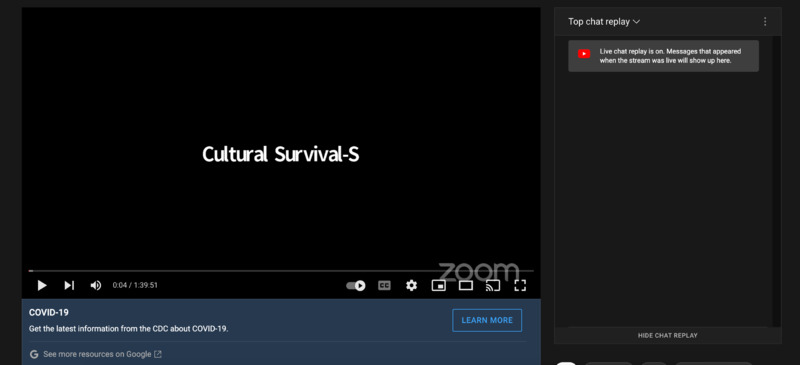 2020-08-19
2020-08-19Pueblos Indígenas: ¿Cómo enfrentar la pandemia del COVID-19?
Cultural Survival realizó un foro para discutir "Pueblos Indígenas: ¿Cómo enfrentar la pandemia del COVID-19?" Cultural Survival held a forum to discuss "Indigenous Peoples: How to face the COVID-19 pandemic?" -
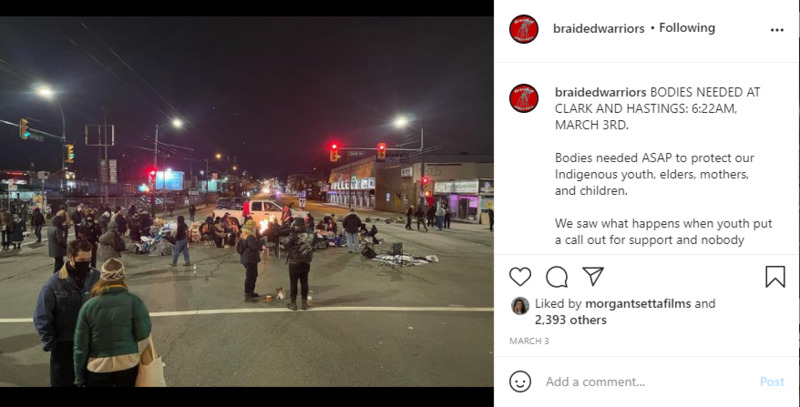 2021-03-03
2021-03-03Bodies Needed
This is an image of a protest blockade in support of a jailed Indigenous elder, who was arrested for protesting at the Trans Mountain pipeline construction sites in Burnaby, BC. The elder, Stacy Gallagher was arrested while preforming a smudging ceremony. This blockade was organized by the Braided Warriors, calls on their social media platforms brought more bodies to help maintain the barracade against the agents of the Canadian state and the Crown. The post's description stated, "BODIES NEEDED AT CLARK AND HASTINGS: 6:22AM, MARCH 3RD. Bodies needed ASAP to protect our Indigenous youth, elders, mothers, and children. We saw what happens when youth put a call out for support and nobody showed up - Indigenous youth, mothers, and elders were violently attacked - left with concussions and lasting injuries we are still recovering from. Numbers are low and early morning is typically when police move in. People have been holding it down here all night, and need bodies down here immediately. When our numbers dwindle, we are in danger. The Crown will not hesitate to criminalize Indigenous peoples. Your inaction is complacency, and complacency is violence. Put your body on the line. PROTECT OUR INDIGENOUS CHILDREN, YOUTH, MOTHERS, AND ELDERS. PROTECT THE SACRED FIRE." The comments of this post have messages of solidarity, people organizing for food and water, and those stating they would be arriving on the scene to help. -
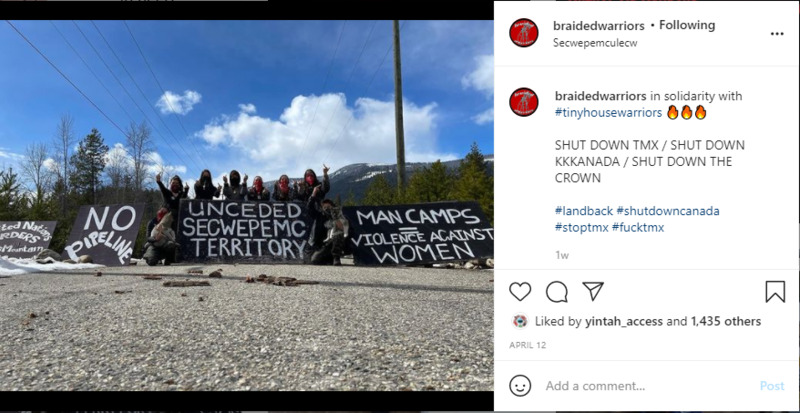 2021-04-12
2021-04-12Solidarity with Tiny House Warriors
An image of land defenders and their blockade on Secwepemc territory. These land defenders are calling for a cessation of the construction on the Trans Mountain Pipeline, which runs through unceded Secwepemculecw and Wet'suwet'en territories. While these piplines represent a threat to the ecology of the region, the construction represents the continuation of Canada's colonial reality into the years of pandemic. Furthermore, the construction of this pipeline has resulted in the creation of several work camps for transient labourers which have been called 'man camps.' These camps have been identified as a threat to indigenous communities, with particular threat of violence against First Nations women in the areas surrounding these camps, they have also been linked to the perpetuation of one of Canada's greatest crimes, MMIW (Missing and Murdered Indigenous Women). As identified by the supplementary report on the Missing and Murdered Indigenous Women in 2019, the perpetuation of this crisis and the lack of action on behalf of the Canadian state is a genocide, according to the U.N.'s definition of genocide. In truth, it is continuation of the genocidal campaigns against First Nations peoples across North America, the pursuit and extraction of capital by exploiting the land and the peoples who walked upon it first. These Tiny House Warriors in the comments call for land back, and a general campaign to shut down Canada. As of now, construction on the TMX continues unabated, the government of Canada shows no sign of upholding the call to Truth and Reconciliation. -
 2021-04-07
2021-04-07Indigenous Peoples and Vaccines
“The coronavirus (COVID-19) pandemic poses a grave health threat to Indigenous peoples around the world. Indigenous communities already experience poor access to healthcare, significantly higher rates of communicable and non-communicable diseases, lack of access to essential services, sanitation, and other key preventive measures, such as clean water, soap, disinfectant, etc.” -
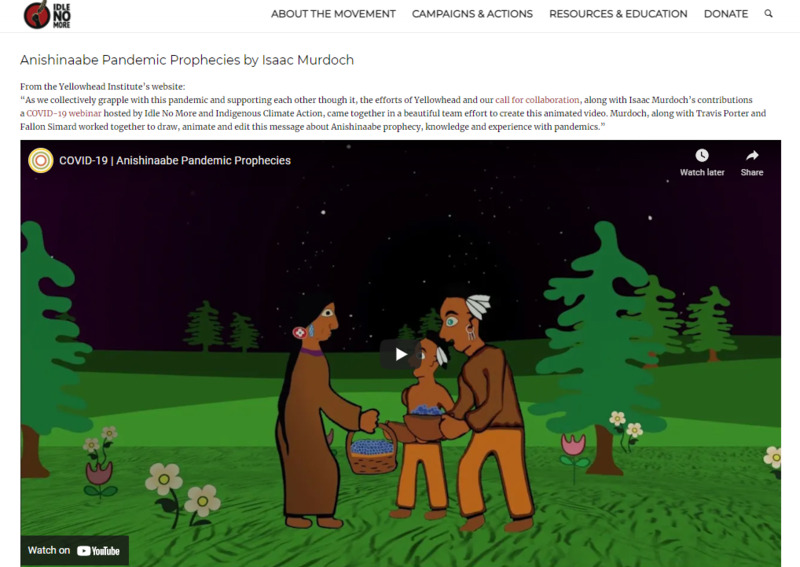 2020-05-19
2020-05-19Anishinaabe Pandemic Prophecies by Isaac Murdoch
From the Yellowhead Institute’s website: “As we collectively grapple with this pandemic and supporting each other though it, the efforts of Yellowhead and our call for collaboration, along with Isaac Murdoch’s contributions a COVID-19 webinar hosted by Idle No More and Indigenous Climate Action, came together in a beautiful team effort to create this animated video. Murdoch, along with Travis Porter and Fallon Simard worked together to draw, animate and edit this message about Anishinaabe prophecy, knowledge and experience with pandemics.” -
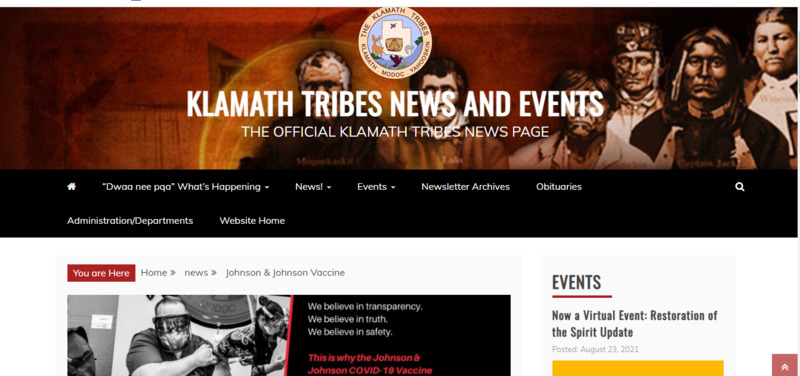 2021-04-15
2021-04-15The Klamath Tribes halt use of Johnson and Johnson vaccine
The Klamath Tribes stopped administering the J&J vaccine on April 9, 2021 after concerns of major side effects, a few days before the FDA and CDC paused administering of the vaccine. -
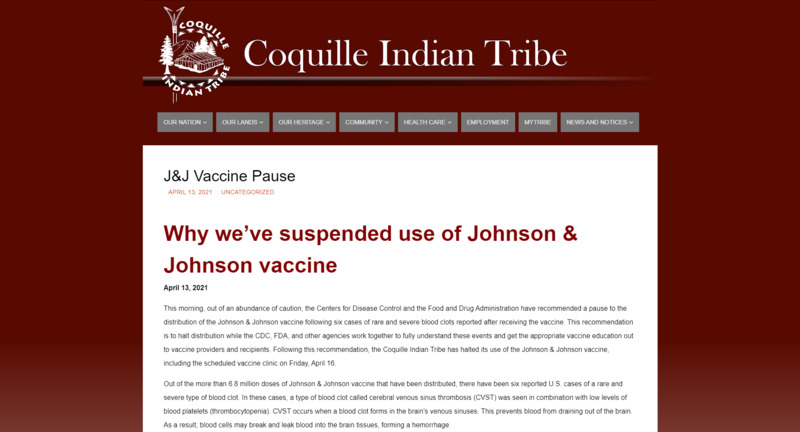 2021-04-21
2021-04-21Coquille Indian Tribe pauses distribution/use of Johnson and Johnson vaccine
"The Coquille Indian Tribe has suspended use of Johnson & Johnson’s COVID-19 vaccine. This action is taken in response to a federal recommendation involving six reported U.S. cases of a “rare and severe” type of blood clot." -
 2021-04-13
2021-04-13Tribes of north-central Montana pause use of Johnson and Johnson vaccine under recommendation by CDC and FDA
"Native American tribes in north-central Montana are responding to today's CDC and FDA recommendations that the Johnson & Johnson COVID vaccine temporarily stop being used. The reason for the "pause" is because it has been linked to blood clots in at least six people out of the more than 6.8 million who have received that version of the vaccine." Tribes including Little Shell Tribe, Rocky Boy Reservation, and The Blackfeet Tribe are coordinating with providers and pausing use of the Johnson and Johnson vaccine. -
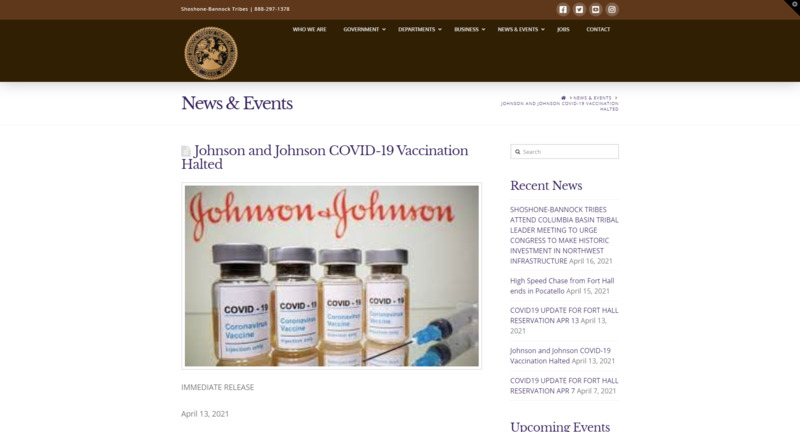 2021-04-13
2021-04-13Shoshone-Bannock Tribes pause use of J&J vaccination following guidance of CDC and FDA
IHS, Shoshone-Bannock Community Health Center (HRSA), and Tribal Health and Human Services (THHS) will halt the Johnson and Johnson vaccination until we have official confirmation of the vaccine safety and guidance. -
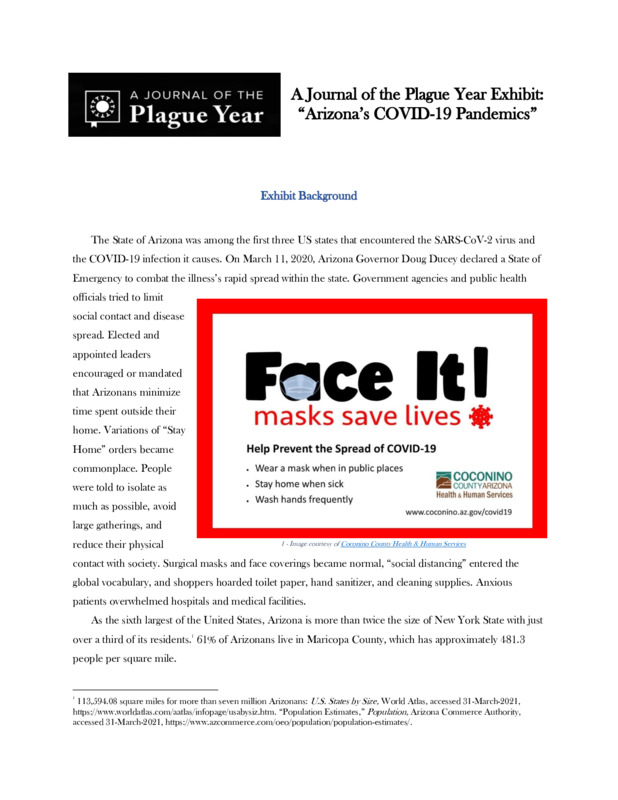 2021-04-20
2021-04-20JOTPY Exhibit: "Arizona's COVID-19 Pandemics" by James Rayroux
While working as a curatorial intern on ASU's 'A Journal of the Plague Year' COVID-19 archive, I created this exhibit on the pandemic experience within the state. In addition to obvious, overarching realities such as socioeconomic status and immediate access to healthcare systems, I initially believed one of the greatest deciding factors that determined one's experience in Arizona was an individual's residence in either predominantly urban or rural environments. The proposed exhibit had been originally titled "A Tale of Two Arizonas" to pay respect to Charles Dickens and the differing realities experienced here. To test my proposed hypothesis, I went about finding data, stories, and submissions that substantiated or disputed my premise. Within a short time, I had identified four distinct environmental drivers of personal pandemic experiences; to me, that indicated the existence of many more I hadn't yet found or had overlooked along the way. My evidence suggested a minimum of four pandemic locales: Urban, Rural, Border, and Tribal within the State of Arizona and its fifteen counties. The recorded health data and personal experiences demonstrated the naivete of my initial hypothesis, and I retitled the exhibit: "Arizona's COVID-19 Pandemics." The Exhibit Background section illustrates the vast dichotomies within Arizona in terms of population density and access to healthcare facilities. Given the virus's respiratory nature, these factors seemed especially relevant to driving diverse local experiences. I chose to include a flyer from the Coconino County Health and Human Services' "Face It! Masks Save Lives" campaign. The flyer included a specific line to "Stay Home When Sick" that seemed to illustrate a different public health paradigm than the broader "stay home" orders from Maricopa and Pima county. This section also features an image of Sedona's red rocks and a portion of The Wave to remind visitors of the wide-open rural areas accessible to all, as well as those with cultural significance to the Native American tribes and limited access to the general public. The next section asks a short, five-question survey in which visitors may participate. The Silver Linings piece features a short audio clip of a father and husband discussing some unexpected benefits of the pandemic. Visitors may explore additional Silver Linings stories and submit their own experience. The Tséhootsooí Medical Center piece seeks to illustrate the different pandemic experience on the state's tribal lands. I hoped to inspire some relevant emotional turmoil for the visitors through the piece's visual presentation. I wanted to create a series of waves with quotes from the medical center's healthcare workers. I hoped visitors' attention would be drawn to the large, bolded key words, and that they would first experience the segments out of sequence because of that. After potentially feeling a sense of chaos, they might settle themselves into a deliberate reading of the texts and find their own order within the experiences provided here. This piece allows further exploration of Native submissions and topics, a review of an additional related news article, and a submission prompt that invites visitors to offer guidance to hospital managers. The next piece illustrates the differences between mask mandates in communities across Arizona. In addition to hearing an audio clip of interviews with mayors and a public health official, visitors can explore additional submissions related to mask mandates and submit their thoughts on statewide mandates. The Arizona Department of Health Services provides zip-code specific infection data on its website, and the wide array of known case infections therein further illustrates potential dichotomies across the state. In working to include and represent this data in a consumable way, I encountered inconsistencies with tribal data. The nation's Indian tribes are overseen by Indian Health Services, a federal public health agency, and it does not collect or report data in the same manner as the State of Arizona or its counties. At first glance, the data would seem to suggest that tribal areas had less severe pandemic experiences than the rural and urban areas, which was not objectively true. I wanted to offer the unedited data to visitors, allow them to drawn their own conclusions, and invite them to offer their thoughts on what potential misunderstandings might emanate from these reporting differences. Visitors may also choose to review the foundational data from this piece, as well. I used the following two sections to offer submission prompts about the visitor's overall pandemic experience as a function of their location, as well as what they might have done if placed in charge of their city, county, or state during this pandemic. A diverse Search section allows visitors to explore additional topics of interest to them. 23 hyperlinks offer pre-defined search parameters. An Advanced Search link allows self-defined research, and a Join The Staff link connects visitors with opportunities to work within the JOTPY archive. A final section asks visitors to provide feedback on the exhibit, its content, and the pandemic in general. Both surveys within the exhibit will display overall results to visitors who participate in them. Through this process, I found incredible amounts and diversity of data outside the archive that spoke to these generally localized experiences, but not that much yet within the archive explained what Arizonans had experienced outside the state's urban environments. I created a call for submissions and delivered it to fifty rural entities that might help support the effort to collect and preserve more rural Arizona stories. Between all the local libraries, historical societies, museums, small-town mayors, and county health officials to whom I asked for help, I am optimistic the archive will better represent all Arizonans in the coming months and years. Despite the exhibit having been created, I ensured its internal search features would include future submissions and allow the exhibit to remain relevant long after its release. -
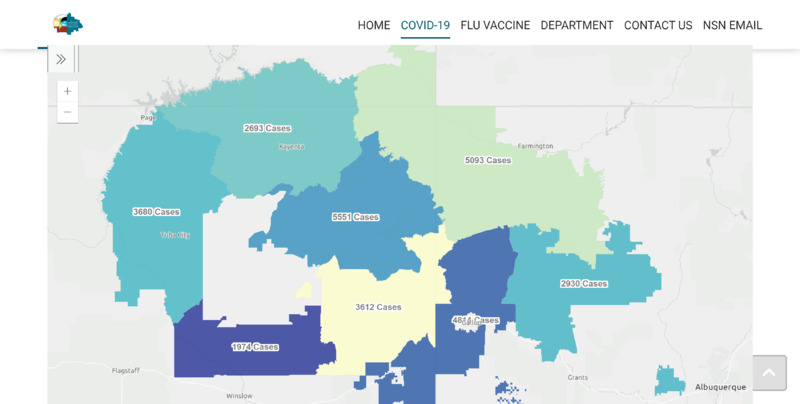 2021-04-19
2021-04-19Navajo Department of Health COVID-19 Case Infection Data by Region through 19 April 2021
This image, taken as a screenshot from the Navajo Department of Health website on 19 April 2021, shows COVID-19 infection case data by region within the Navajo Nation. -
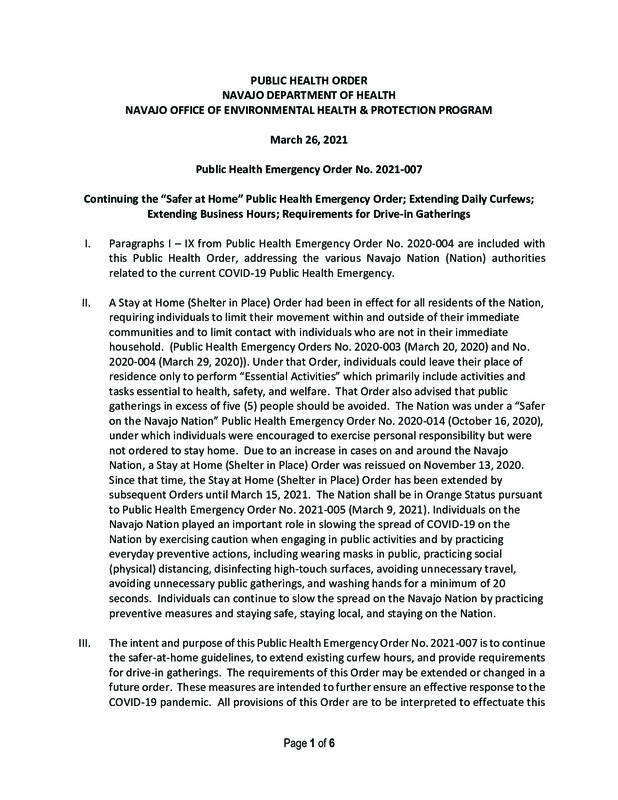 2021-04-19
2021-04-19Navajo Department of Health Public Health Emergency Orders through 19 April 2021
These eight documents are the eight Public Health Emergency Orders issued by the Navajo Department of Health issued through 19 April 2021. -
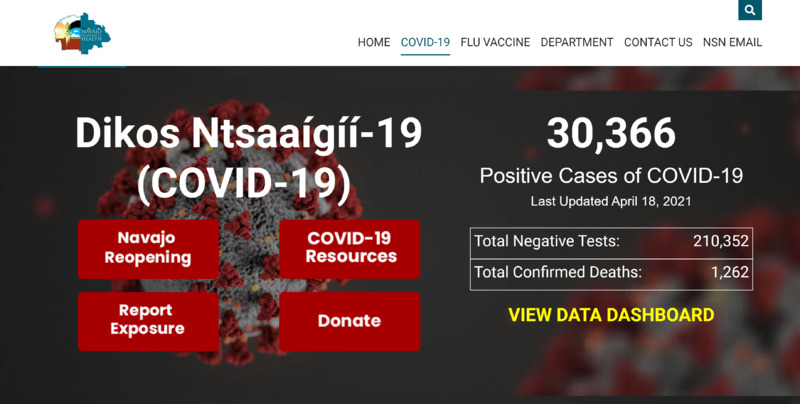 2021-04-19
2021-04-19Navajo Department of Health Data & Website
Despite recent data and statistical successes, the NDOH has left its 10pm to 5am curfew in place. The site offers a dashboard with current COVID-19 information, in terms of both resources and data. -
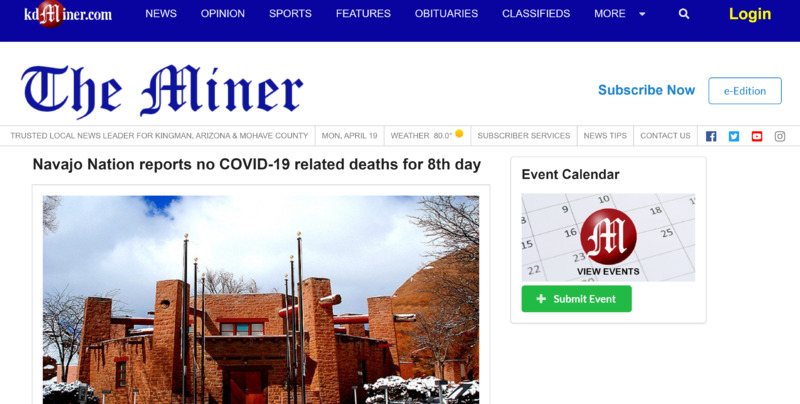 2021-04-19
2021-04-19News Article: Navajo Nation reports no COVID-19 deaths for 8th day
By Associated Press, 19 April 2021 WINDOW ROCK (AP) — The Navajo Nation is finding no new COVID-19 related deaths for an eighth consecutive day. The tribe on Sunday afternoon reported seven new virus cases but no additional deaths on the vast reservation. The latest numbers bring the Navajo Nation's pandemic case total to 30,366 with the death toll remaining at 1,262. Tribal officials said 16,477 people have recovered from COVID-19 thus far. The tribe had been easing into reopening but that slowed somewhat after coronavirus variants were confirmed on the reservation, which stretches into New Mexico, Utah and Arizona. Tribal officials urged residents to stay vigilant. Navajo President Jonathan Nez said the tribe recently had a cluster of COVID-19 cases as a result of a family gathering where people were not wearing masks. Tribal public health orders mandate that masks be worn on the reservation and a daily curfew is in effect. Restaurants cannot have dine-in services. Navajo Nation roads also are closed to visitors and tourists, which doesn’t affect travel on state highways that run through the reservation. Meanwhile, health care facilities across the reservation continue to offer the vaccine by appointment or at drive-thru events. -
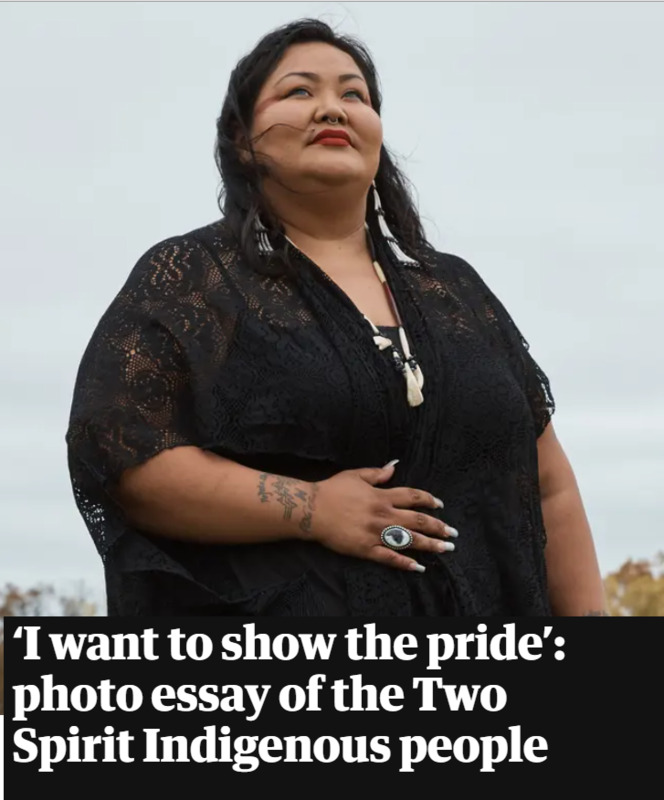 2021-04-12
2021-04-12‘I want to show the pride’: photo essay of the Two Spirit Indigenous people
Two-Spirit, the term used to describe LGBTQ Indigenous, are fighting to be recognized amongst their own people. Although Indigenous, they claim their sacred circle was broken when colonizers landed on their soil and are now viewed upon with pity. Fighting to regain equal rights, the Two-Spirit community refuses to be marginalized. They work to convince other South Dakota tribes to legalize same-sex marriage and pass LGBTQ hate crime legislation. Two-Spirit member, Monique Mousseau stated, “Our younger generation needs to be acknowledged for who they are. It’s important for them to know that they are who they are and that it’s OK,” Mousseau says. “It’s time to acknowledge we have always been here, and we will always be here.” -
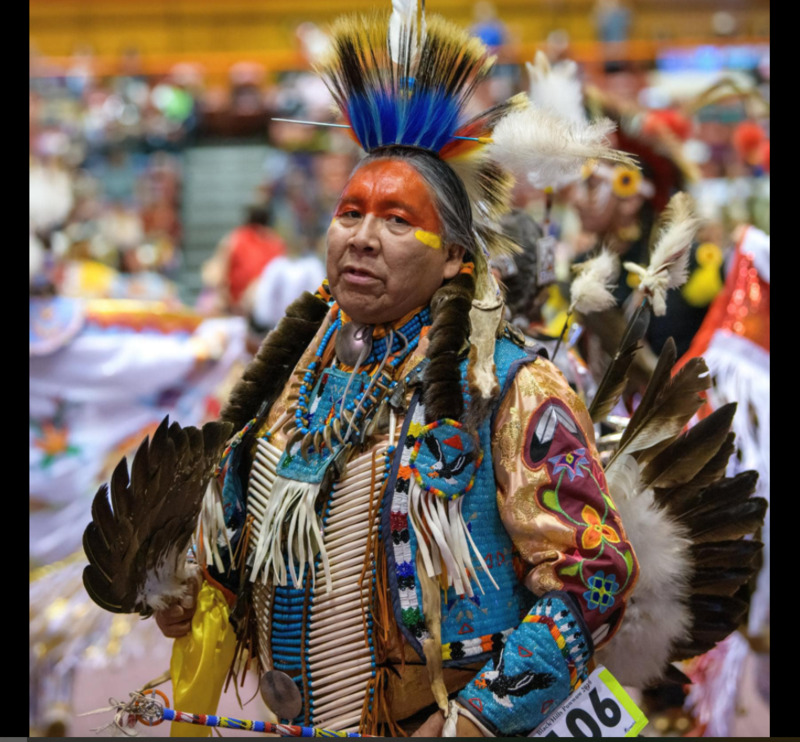 2021-04-17
2021-04-17Represent like Elvin Fourfeathers!
This photo was posted on the Social Distance Powwow Facebook page. Fourfeathers’s face seems to hold a thought captive. Was he going to say something to the photographer? What is he thinking? Would I even understand as a non-Indigenous person? What do the different pieces of regalia represent? Did the photographer take this pre-pandemic but posted now lamenting the loss of tribal gatherings? So many questions to such a beautiful photograph. You keep on representing Elvin. Teach us all. -
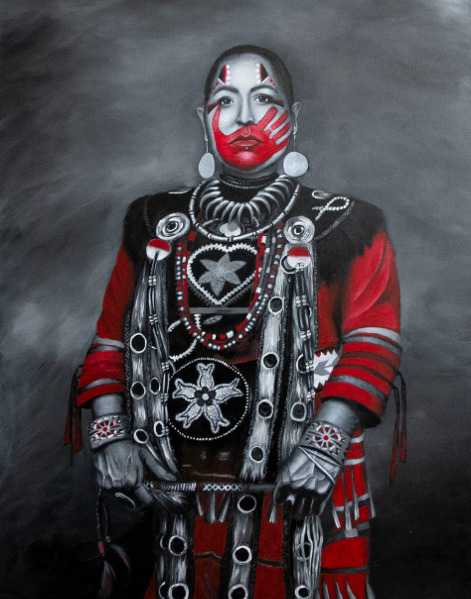 2021-04-18
2021-04-18"Kimberly in Red" by Indigenous Artist Nayana Lafond
Indigenous artist, Nayana Lafond, painted this piece as part of the Missing & Murdered Indigenous Women & Girls (MMIWG) exhibition. The exhibit was designed to advocate for these missing women and to stop the violence against Indigenous women. On her website, Lafond features "Kimberly in Red" with the following description, "Kimberly LaRouge, Ojibwe from Lac Courte Oreilles Wisconsin. Mother, grand mother, motorcycle racer, traditional jingle dancer and badass." I would encourage everyone to visit Lafond's website and view her powerful and emotional art pieces. -
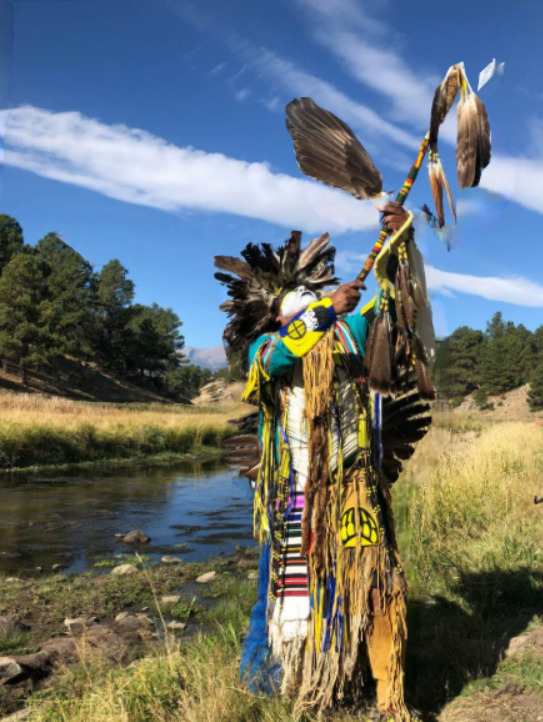 2021-04-14
2021-04-14Social Distance Powwow - Prayers for All Nations
Social Distance Powwow is a Facebook page created so Indigenous Peoples can virtually powwow together. Bear Cadman, a member of Dine Nation, submitted this photo of him and wrote "Prayers for all nations. Prayers for peace and healing. Love will win. Prayers for all of you the 5 finger nation." -
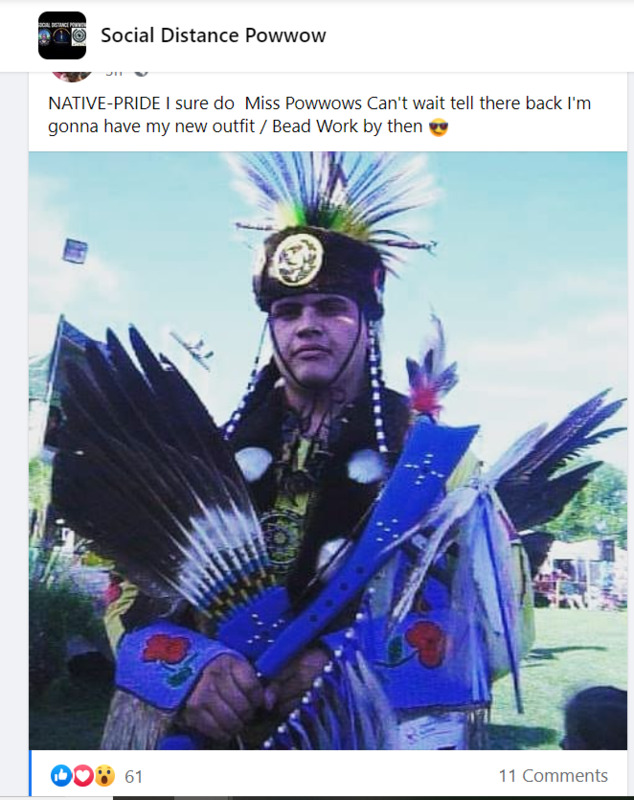 2021-04-18
2021-04-18Social Distance Powwow - Native Pride
Native Alec BigCanoe posted a photo of himself wearing his father's regalia on the Social Distance Powwow Facebook page. He looks forward to powwows starting again. -
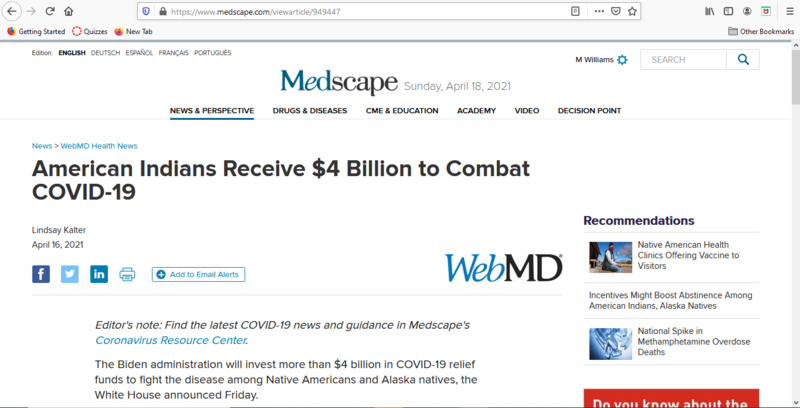 2021-04-16
2021-04-16Indigenous populations and COVID assistance
This article is about the government's assistance to help Native Americans and Alaska natives combat COVID-19. The Biden administration announced that they will put $4 billion of assistance. The money will be used for things like testing, treatment, and vaccines for these indigenous populations. This is critically important as the CDC announced that Native American and Alaskan Native populations are up to 3.5x more likely to contract COVID-19 than white people. One of the things that the article also notes is that confidence in getting the vaccine will also be an important factor in diminishing that 3.5x number. Efforts to educate specific populations on the vaccine will help the money, but there is a lot of work still to be done. -
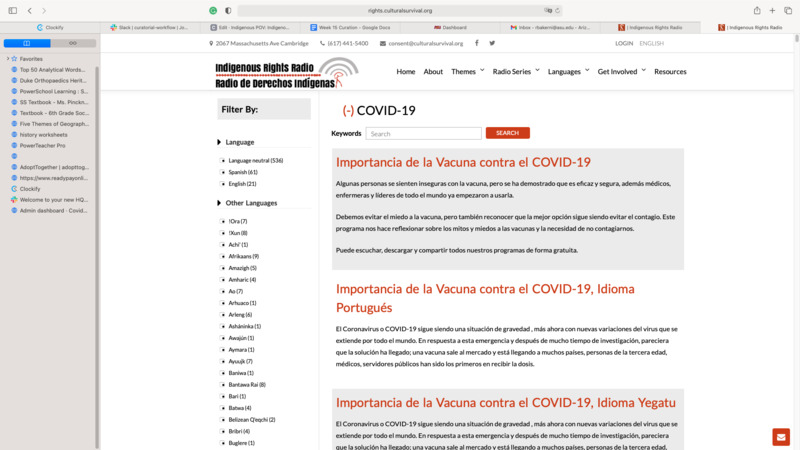 2003
2003Indigenous POV: Indigenous Rights Radio discusses COVID-19 in 145 languages
Indigenous Rights Radio has posted interviews with Indigenous Peoples around the globe discussing COVID-19. -
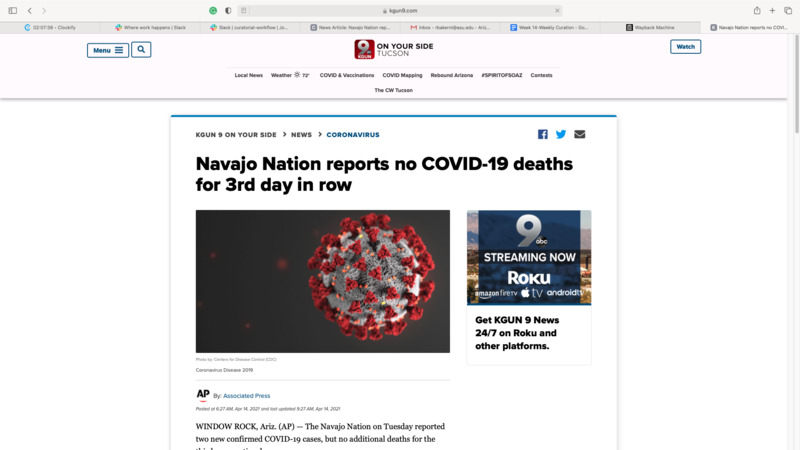 2021-04-14
2021-04-14News Article: Navajo Nation reports no COVID-19 deaths for 3rd day in row
Despite very grim months through the last year's COVID-19 pandemic in the Navajo Nation, the Associated Press reported continuing indications of success for the Navajo people and their rural communities: WINDOW ROCK, Ariz. (AP) — The Navajo Nation on Tuesday reported two new confirmed COVID-19 cases, but no additional deaths for the third consecutive day. The latest numbers brought the pandemic totals on the tribe’s reservation to 30,269 cases and 1,262 known deaths. Tribal officials had ordered a lockdown last weekend over fears that a new variant could drive another deadly surge. The Stay-At-Home order required all Navajo Nation residents to refrain from unnecessary travel to help limit the spread of the virus, including a new and more contagious strain. Navajo Nation President Jonathan Nez recently announced the first confirmed case of the COVID-19 B.1.429 variant on the reservation that covers parts of Arizona, New Mexico and Utah. -
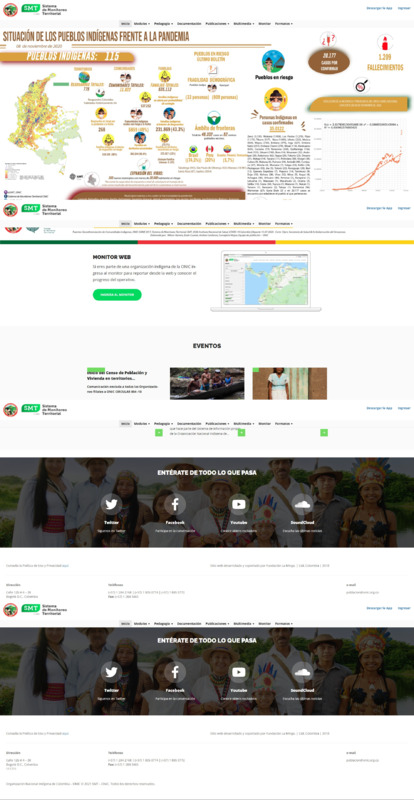 2020
2020Sistema de monitoreo territorial
"El Sistema de Monitoreo Territorial es una plataforma de recolección y generación de información que hace parte del sistema de información propio de la Organización Nacional Indígena de Colombia." "The Territorial Monitoring System is a platform for collecting and generating information that is part of the information system of the National Indigenous Organization of Colombia" -
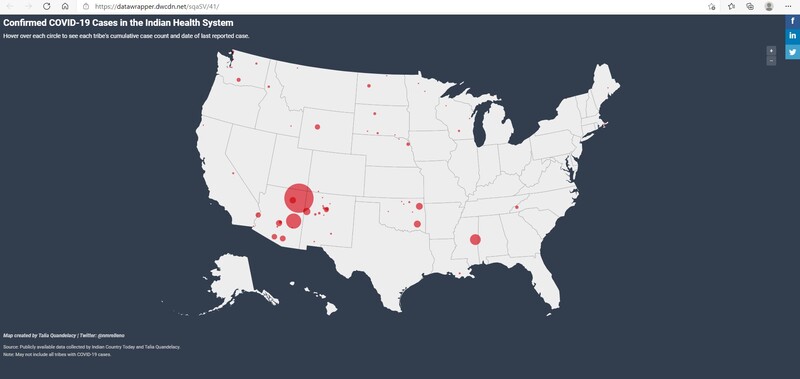 2020-07
2020-07Confirmed COVID-19 Cases in the Indian Health System
This data is presented by Talia Quandelacy, Infectious Disease Epidemiologist and Native American, to illustrate COVID-19 cases/deaths in Native American communities in July 2020, from publicly available information. -
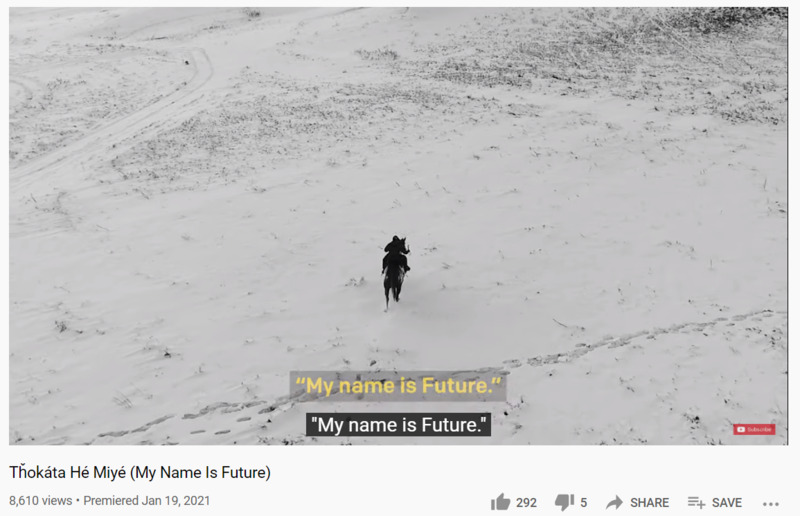 2021-01-19
2021-01-19Tȟokáta Hé Miyé (My Name Is Future)
A film by the Standing Rock Sioux Tribe and Earthjustice Written and Directed by Josué Rivas Narrated by Grace DeRockbrain Cinematography by: Josué Rivas, Adam Johansson. Drone2Bwild, Digital Smoke Signals, Akicita Film Edited by Dylan Sylwester Audio by Natalie Huizenga Community Outreach and Recording: Sunshine Woman Grace DeRockbrain (Standing Rock Sioux Tribe) Teena Pugliese and AnnaLee Yellow Hammer Translation: Doug Goodfeather Co-Producers: Rebecca Bowe and Chris Jordan-Bloch for Earthjustice -
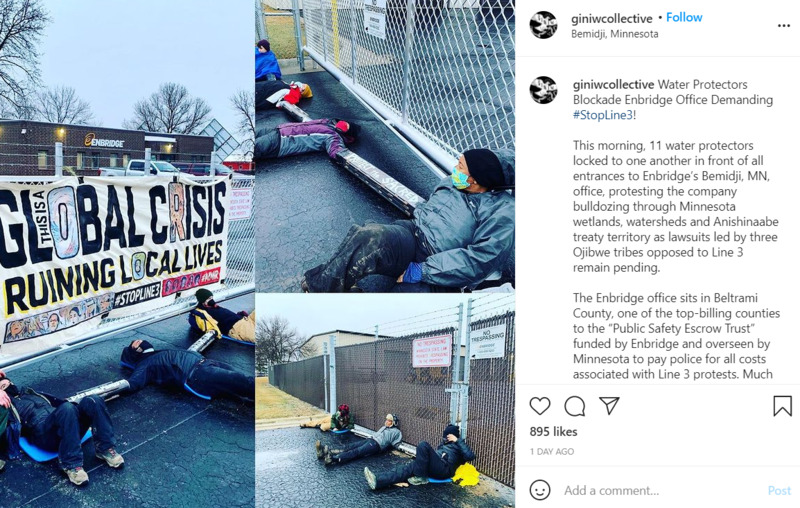 2021-04-09
2021-04-09Water Protectors Blocade Enbridge Office Demanding #StopLine3!
Water Protectors Blockade Enbridge Office Demanding #StopLine3! This morning, 11 water protectors locked to one another in front of all entrances to Enbridge’s Bemidji, MN, office, protesting the company bulldozing through Minnesota wetlands, watersheds and Anishinaabe treaty territory as lawsuits led by three Ojibwe tribes opposed to Line 3 remain pending. The Enbridge office sits in Beltrami County, one of the top-billing counties to the “Public Safety Escrow Trust” funded by Enbridge and overseen by Minnesota to pay police for all costs associated with Line 3 protests. Much of Northern Minnesota has heavily militarized, purchasing riot gear, less lethal weapons and ammunition, etc. Law enforcement along the proposed route have billed thousands of hours of “overtime” to Enbridge, with Cass County alone billing 7,500 hours to the Enbridge escrow account in 3 months. Indigenous people and local residents have reported heavy surveillance, targeted pullovers and harassment by law enforcement in connection with Line 3 resistance. Water Protector Khalea said, “During Ferguson so many people came out and supported us, and I want to keep doing that... I am here for the liberation of all oppressed people, for the earth, for the liberation of all of our people, I am here to stand with Mother Earth and to protect the water and the wild rice and to stand with my Indigenous friends and loved ones as we all fight this collectively, we are all opposing these systems of oppression.” Water Protector Alex said, “This is part of my responsibility as someone who is a guest on this land and as someone who faces the impacts of climate change. Enbridge lies.” Water Protector Ishmaiah said, “I have spent the last several years fighting for the liberation in St. Louis, specifically Black St. Louis, and I see this as expanding and having a more holistic approach to what that fight can look like, because this land and this water touches us, and I think without that connection, grounding myself in the land and the water, doing solidarity with my Indigenous family, we can sometimes forget about the universal struggles around us.” -
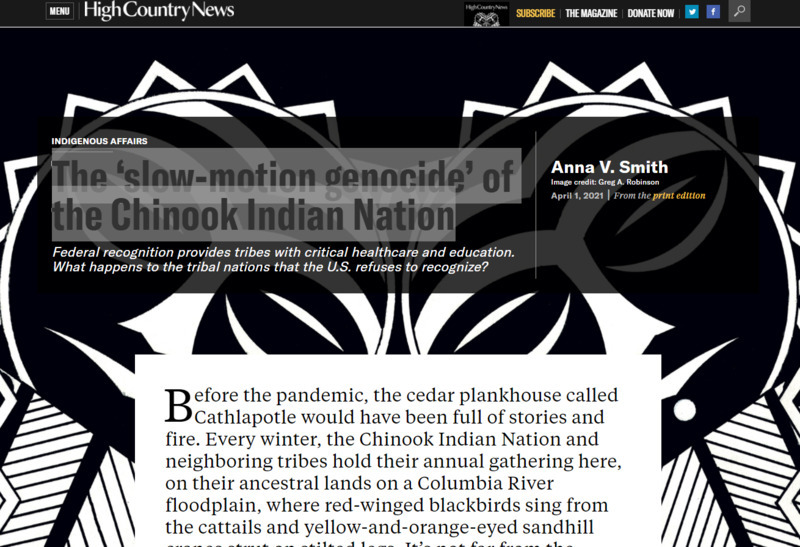 2021-04-01
2021-04-01The ‘slow-motion’ genocide’ of the Chinook Indian Nation
The pandemic has exacerbated the Chinook’s lack of the kind of social safety net recognized tribes possess. While the COVID-19 mortality rate of Indigenous people is almost 2.5 times that of white people, unrecognized tribes have not received any of the $8 billion in government aid passed by Congress last spring. Nor have they received priority for tests or vaccines. Instead, they have to rely on neighboring tribes like the Grand Ronde and the Shoalwater Bay Tribe to vaccinate their elder knowledge-keepers. Chinook tribal members sometimes refer to the lack of recognition as slow-motion genocide. “Explain how it’s not genocide,” Johnson said to me. “Someone explain to me how it’s not.” -
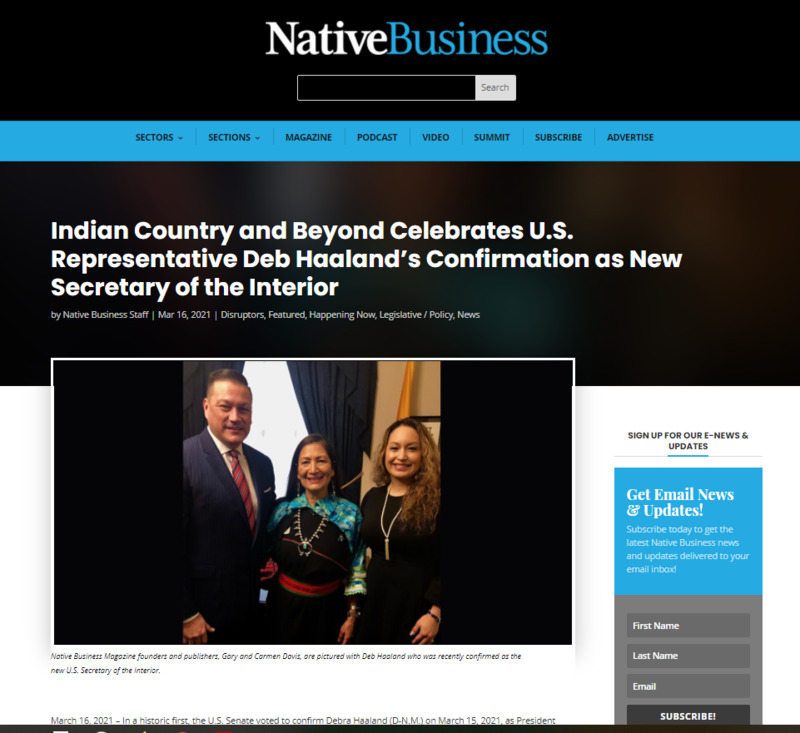 2021-03-16
2021-03-16Indian Country and Beyond Celebrates U.S. Representative Deb Haaland’s Confirmation as New Secretary of the Interior
In a historic first, the U.S. Senate voted to confirm Debra Haaland (D-N.M.) on March 15, 2021, as President Biden’s secretary of the U.S. Department of Interior, making the second-term Democrat the first ever Native American to be a member of a White House Cabinet in U.S. History. In this role, Secretary Haaland, an enrolled member of the Laguna Pueblo, will oversee 70,000 employees and the country’s natural resources. The Department manages nearly 500 million acres of land, and notably, the Bureau of Indian Affairs and Bureau of Indian Education. -
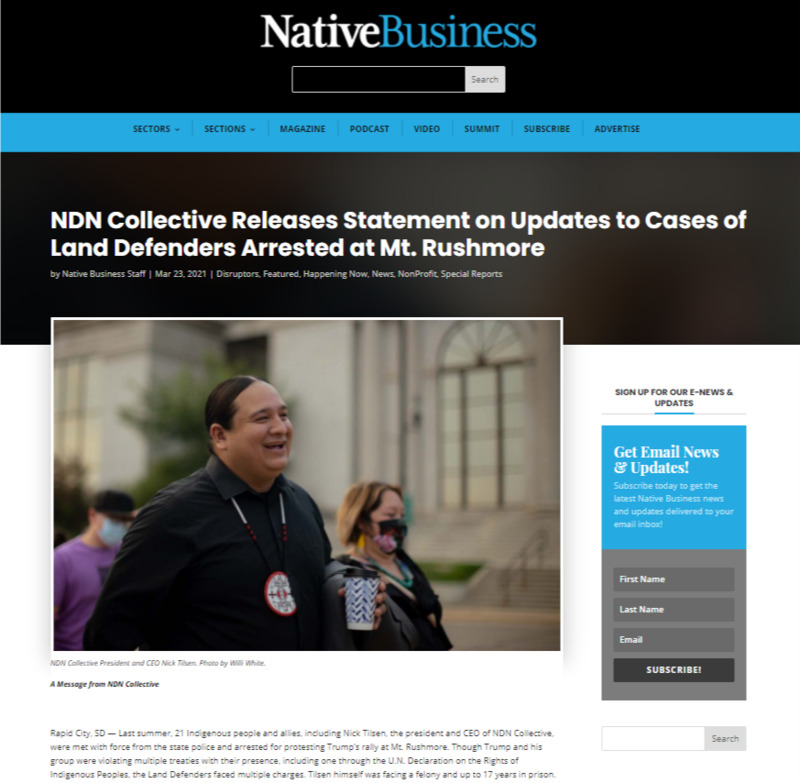 2021-03-23
2021-03-23NDN Collective Releases Statement on Updates to Cases of Land Defenders Arrested at Mt. Rushmore
Last summer, 21 Indigenous people and allies, including Nick Tilsen, the president and CEO of NDN Collective, were met with force from the state police and arrested for protesting Trump’s rally at Mt. Rushmore. Though Trump and his group were violating multiple treaties with their presence, including one through the U.N. Declaration on the Rights of Indigenous Peoples, the Land Defenders faced multiple charges. Tilsen himself was facing a felony and up to 17 years in prison. Today, NDN Collective announced that the charges for Tilsen and all other activists arrested on July 3 will be dropped. This announcement comes after months of political pressure from grassroots groups, including petitions, social media campaigns, and local and national media coverage of the cases.
